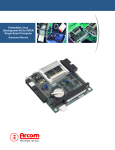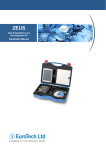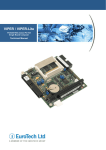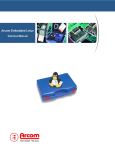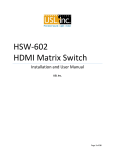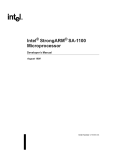Download Eurotech VIPER-Lite Datasheet
Transcript
VIPER RedBoot and AEL Quickstart
VIPER / VIPER-Lite
Entry Level Embedded Linux
Development Kit
Quickstart Manual
Contents
VIPER / VIPER-Lite Embedded Linux Development Kit Quickstart
Definitions
Arcom is the trading name for Arcom Control Systems Inc and Arcom Control Systems Ltd.
Disclaimer
The information in this manual has been carefully checked and is believed to be accurate. Arcom assumes no responsibility
for any infringements of patents or other rights of third parties, which may result from its use.
Arcom assumes no responsibility for any inaccuracies that may be contained in this document. Arcom makes no commitment
to update or keep current the information contained in this manual.
Arcom reserves the right to make improvements to this document and/or product at any time and without notice.
Warranty
This product is supplied with a 3 year limited warranty. The product warranty covers failure of any Arcom manufactured product
caused by manufacturing defects. The warranty on all third party manufactured products utilized by Arcom is limited to 1 year.
Arcom will make all reasonable effort to repair the product or replace it with an identical variant. Arcom reserves the right to
replace the returned product with an alternative variant or an equivalent fit, form and functional product. Delivery charges will
apply to all returned products. Please check www.arcom.com/support for information about Product Return Forms.
Trademarks
Linux is a registered trademark of Linus Torvalds.
RedBoot, Fedora and Red Hat are registered trademarks of Red Hat Inc. This product contains a copy of the installation
media for the Fedora Core Linux distribution. This media is not a product of Red Hat, Inc. or the Fedora project and is not
endorsed by Red Hat, Inc. or the Fedora project. It is a product of Arcom and we have no relationship with Red Hat, Inc. or
the Fedora project. The media is identical in every respect to the standard Fedora Core install media.
ARM and StrongARM are registered trademarks of ARM Ltd.
Intel and XScale are trademarks or registered trademarks of Intel Corporation or its subsidiaries in the United States and
other countries.
CompactFlash is the registered trademark of SanDisk Corp.
All other trademarks and copyrights referred to are the property of their respective owners.
This product includes software developed by the University of California, Berkeley and its contributors.
Revision History
Manual
PCB
Date
Comments
Issue A
18th Aug 2006
First release of manual.
Issue B
25th Sep 2006
Update for Development Kit’s Ethernet cable contents and
corresponding changes.
© 2006 Arcom.
Arcom is a subsidiary of Eurotech Group.
www.eurotech.com
For contact details, see page 31.
Arcom operates a company-wide
quality management system, which
has been certified by the British
Standards Institution (BSI) as
compliant with ISO9001:2000
VIPER / VIPER-Lite Embedded Linux Development Kit Quickstart
Contents
Contents
Introduction ........................................................................................................................................4
Handling your board safely ....................................................................................................4
About this manual ..............................................................................................................................5
Related documents ................................................................................................................5
Conventions ...........................................................................................................................6
Getting started ...................................................................................................................................7
What’s in the kit?....................................................................................................................7
What else do I need? .............................................................................................................8
What peripherals are supported?...........................................................................................9
Unpacking and connecting up..........................................................................................................10
Power supply ...................................................................................................................................13
RedBoot ...........................................................................................................................................14
What is RedBoot? ................................................................................................................14
Arcom Embedded Linux (AEL) ........................................................................................................16
What’s in AEL?.....................................................................................................................16
Booting the system ..............................................................................................................16
Logging in ............................................................................................................................17
Setting up networking ..........................................................................................................18
The file system.....................................................................................................................19
Linux kernel..........................................................................................................................20
Hardware configuration........................................................................................................21
Software configuration .....................................................................................................................28
Examples for VIPER / VIPER-Lite ...................................................................................................29
Target support software ...................................................................................................................30
Appendix - Contacting Arcom ..........................................................................................................31
Index ................................................................................................................................................32
© 2006 Arcom
Issue B
3
VIPER / VIPER-Lite Embedded Linux Development Kit Quickstart
Introduction
Introduction
The VIPER / VIPER-Lite is an ultra low power PC/104 form-factor single board
computer based on the Intel 400MHz PXA255 (VIPER) or 200MHz PXA255
(VIPER-Lite) XScale processor. The PXA255 is an implementation of the Intel XScale
micro-architecture combined with a comprehensive set of integrated peripherals
including:
•
Flat panel graphics controller.
•
Interrupt controller.
•
Real time clock (RTC).
•
Multiple serial ports.
The VIPER / VIPER-Lite board offers many features that make it ideal for powersensitive embedded communications and multimedia applications.
The Embedded Linux Development Kit provides a ready-to-run platform for Linux
application development and deployment. Arcom Embedded Linux is based on the
standard v2.6 kernel and has been configured to load and run from embedded Flash
memory.
Handling your board safely
Anti-static handling
The SBC and other circuit boards contain CMOS devices. These could be damaged in
the event of static electricity being discharged through them. Please observe anti-static
precautions at all times when handling circuit boards. This includes storing boards in
appropriate anti-static packaging and wearing a wrist strap when handling them.
Packaging
Should a board need to be returned to Arcom, please ensure that it is adequately
packed, preferably in the original packing material.
© 2006 Arcom
Issue B
4
VIPER / VIPER-Lite Embedded Linux Development Kit Quickstart
About this manual
About this manual
This manual gets you started using the VIPER / VIPER-Lite with RedBoot and Arcom
Embedded Linux (AEL). It lists the items you should find in your kit, and tells you how to
unpack, connect and configure the board.
Arcom Embedded Linux for VIPER / VIPER-Lite is based on the standard v2.6 kernel
and includes the essential features for embedded communication and display solutions.
Arcom includes dedicated drivers for the on-board hardware and uses the embedded
Flash memory to store applications.
Related documents
This Quickstart Manual is supplied as part of the Development Kit. Other manuals that
you may need are provided in the \manuals section on the CD-ROM that accompanies
your Development Kit. These include the VIPER / VIPER-Lite Technical Manual, the
AEL Technical Manual and the HOWTO documents. Most of the HOWTO documents
relate to common Linux tasks. Others have been written specifically for features on the
VIPER / VIPER-Lite.
Detailed information about AEL is provided in the AEL Technical Manual. The AEL
Technical manual includes information about the following:
•
Configuration files and boot scripts.
•
Making an application run automatically at boot.
•
AEL contents and configuration.
•
Installation.
•
Example programs and utilities.
•
Secure Shell (SSH).
•
Compiling a kernel.
Please note that the AEL Technical Manual is a generic manual for Embedded Linux
supplied on Arcom boards. As such, the AEL manual uses conventions and examples
that may or may not be specific to your board. It is advised that the AEL manual be
used in conjunction with the instructions and information supplied in the Quickstart and
Technical manuals for your board.
© 2006 Arcom
Issue B
5
VIPER / VIPER-Lite Embedded Linux Development Kit Quickstart
About this manual
Conventions
Symbols
The following symbols are used in this guide:
Symbol
Explanation
Note - information that requires your attention.
Tip - a handy hint that may provide a useful alternative or save time.
Caution - proceeding with a course of action may damage your
equipment or result in loss of data.
VL
Indicates that a feature is not available on the standard VIPER-Lite
configuration. Arcom can provide custom configurations (subject to a
minimum order quantity) for the VIPER-Lite populated with this feature.
Please contact our Sales team (see Appendix - Contacting Arcom,
page 31) to discuss your requirements.
Typographical conventions
This manual contains examples of commands that you can enter. These are shown as
follows:
$ make install DESTDIR=/tmp/target-install
The initial symbol ($ in this case) indicates the prompt that the command is for, and
should not be typed.
The prompts used are explained in the following table:
Prompt
Explanation
$
Linux (bash shell) as a regular user.
#
Linux (bash shell) as root.
RedBoot>
RedBoot command line.
Different fonts are used throughout the manual to identify different types of information,
as follows:
© 2006 Arcom
Font
Explanation
Italics
Parts of a command that should be substituted with appropriate
values.
Bold
Information that you enter yourself.
Screen text
Information that is displayed on screen.
Issue B
6
VIPER / VIPER-Lite Embedded Linux Development Kit Quickstart
Getting started
Getting started
What’s in the kit?
The VIPER / VIPER-Lite Development Kit includes:
•
VIPER-M64-F32, VIPERL-M64-F32 or VIPERL-M64-F16.
•
Optional GPIO based VIPER-I/O board (technical manual included on CD)*.
•
Standard serial port breakout cable (up to five ports).
•
RS-232 serial cable (2m).
•
RS-232 null modem adapter.
•
Flat panel display cable.
•
VIPER FPIF-CRT (breakout assembly with standard CRT socket).
•
Ethernet breakout assembly with standard RJ45 socket.
•
Ethernet crossover cable.
•
GPIO cable with un-terminated ends.
•
Reset switch.
•
+5V @ 4A max (100-240 VAC input) power supply.
•
PC/104 mounting pillars (two sets).
•
Development Kit support and installation CD.
•
Fedora Core 5 installation DVD1.
•
AEL Technical Manual (on CD).
VL
•
USB breakout cable.
VL
•
Audio breakout cable.
* Development Kit option
1
http://fedora.redhat.com
© 2006 Arcom
Issue B
7
VIPER / VIPER-Lite Embedded Linux Development Kit Quickstart
Getting started
What else do I need?
An x86 Linux system compliant with version 1.3 of the Linux Standard Base2 is required
for the Arcom Embedded Linux host environment. Suitable systems include PCs with
Debian GNU/Linux, RedHat Linux, Fedora Core or SUSE Linux. The Fedora Core
installation DVD is supplied for this purpose.
In addition, the following information and equipment may be useful:
•
Networking details for the VIPER. If your network does not have a DHCP server,
ask your network or system administrator for the following:
- IP address and subnet mask (netmask).
- Default gateway IP address (if required).
- Name server (DNS) IP address (optional).
•
Networking details for the host machine.
•
Standard Ethernet cable to connect VIPER / VIPER-Lite to a switch or hub.
Alternatively, for standalone systems, the board can be connected directly to your
host machine using the crossover cable provided in the Development Kit.
For more information on setting up a network connection, see the section Setting up
networking, page 18.
2
www.linuxbase.org
© 2006 Arcom
Issue B
8
VIPER / VIPER-Lite Embedded Linux Development Kit Quickstart
Getting started
What peripherals are supported?
The following peripherals/features are supported in this release:
•
Five UARTs, COM1 through COM5, including the processor’s internal FFUART,
BTUART and STUART. The VIPER-Lite is only fitted with three COM ports.
•
On-board Flash array.
•
CompactFlash+.
•
Ethernet interface.
•
A variety of flat panels running with screen resolutions of 320 x 240 or 640 x 480.
•
Power management.
•
GPIO.
•
Real time clock.
•
SRAM.
•
USB client.
VL
•
Audio codec.
VL
•
PC/104 bus. Drivers are available for a range of Arcom and third party PC/104
boards.
VL
•
USB host controller.
VL
•
RS-422 and RS-485 serial port support.
© 2006 Arcom
Issue B
9
VIPER / VIPER-Lite Embedded Linux Development Kit Quickstart
Unpacking and connecting up
Unpacking and connecting up
This section guides you, step-by-step, through the process of connecting up the
VIPER / VIPER-Lite for the first time and powering up the system. The VIPER /
VIPER-Lite is delivered ready to run. There are no link settings or configuration
switches that need to be adjusted for the board to operate.
A number of the components are static-sensitive, so standard anti-static
precautions must be taken during use. For more information, see Anti-static
handling, page 4.
If you follow the procedure described below, the board powers up automatically and
loads the RedBoot boot loader from the on-board Flash array. At this point you can
interrupt the boot process, if you wish, and access the Redboot command prompt. If
you do not interrupt the normal boot sequence, after a 1 second pause, the system
continues to load and boot Linux (AEL).
To power up the VIPER / VIPER-Lite and boot AEL, follow these steps:
1
Remove the VIPER / VIPER-Lite board and all other cables from its packaging. If it
shows any signs of damage during transit, please contact Arcom before proceeding.
Power/Reset input
GPIO header
Audio
USB header
LCD
Ethernet LED
cable
Ethernet data
cable
© 2006 Arcom
Issue B
10
VIPER / VIPER-Lite Embedded Linux Development Kit Quickstart
Unpacking and connecting up
Ethernet LED
cable
Ethernet data
cable
For all connections, the red wire on the cable is pin 1. Pin 1 on each connector is
marked on the board.
2
The VIPER I/O board can be attached above the main VIPER / VIPER-Lite board
once all connections to the main board are complete.
COM1 (with null modem adapter attached)
Audio input/output
Ethernet breakout
AC power supply
VIPER FPIF-CRT
Reset switch
© 2006 Arcom
Issue B
11
VIPER / VIPER-Lite Embedded Linux Development Kit Quickstart
Unpacking and connecting up
3
Fit the VIPER / VIPER-Lite power supply cable to the plug on the board.
4
Connect a serial terminal emulator3 to COM1 using the supplied null modem
adaptor and cable.
5
Configure the serial terminal as follows:
6
•
115200 baud.
•
No parity.
•
8 data bits.
•
No handshaking.
Switch on the VIPER / VIPER-Lite board once the terminal emulator is set up on
the host PC.
The Linux operating system is loaded from the on-board Flash memory, and the
board displays a Linux prompt. For a description of AEL see page 16 of the AEL
Technical Manual, which is in the /manuals/ folder on the Development Kit CD.
3
Such as ‘minicom’ running on a Linux PC or ‘Hyper Terminal’ on a Windows PC.
© 2006 Arcom
Issue B
12
VIPER / VIPER-Lite Embedded Linux Development Kit Quickstart
Power supply
Power supply
The AC Power Supply Unit (PSU) supplied in the kit is rated at 4A @ +5V DC. This is
designed to support the requirements of the VIPER / VIPER-Lite and VIPER-I/O. If
additional devices are powered from this supply, ensure that the overall current rating is
not exceeded.
The following picture shows the PSU connector:
Power lead
Reset Switch
The power connector is polarised to prevent incorrect attachment to the VIPER /
VIPER-Lite board.
© 2006 Arcom
Issue B
13
VIPER / VIPER-Lite Embedded Linux Development Kit Quickstart
RedBoot
RedBoot
What is RedBoot?
RedBoot is a complete bootstrap environment for embedded systems. Based on the
eCos Hardware Abstraction Layer, RedBoot inherits the eCos qualities of reliability,
compactness, configurability, and portability.
RedBoot enables download and execution of embedded applications via serial or
Ethernet, including embedded Linux and eCos applications. It can be used for both
product development (debug support) and in deployed products in the field (Flash
update and network booting).
Ethernet download and debug support is included. This means RedBoot can retrieve its
IP parameters via BOOTP or DHCP, and program images can be downloaded using
TFTP or HTTP. Images can also be downloaded over serial (using X- or Y-modem) or
loaded from a JFFS2 file system on the on-board Flash array.
An interactive command-line interface is accessible via serial or Ethernet and allows
management of Flash images, image download, RedBoot configuration, etc. For
unattended or automated startup, boot scripts can be stored in Flash memory. This
allows, for example, loading of images from Flash or a TFTP server.
You cannot use the command-line interface via Ethernet if you have an
automatic boot script enabled to launch an application or another operating
system. RedBoot does not stop to listen for TCP/IP activity.
The Arcom Embedded Linux (AEL) Technical Manual contains details of many of the
RedBoot commands that are useful when using RedBoot as a boot loader for an
operating system (such as Linux) or to launch an application. Full RedBoot
documentation is available in the eCos Reference Manual, which is in the /manuals/
folder on the Development Kit CD.
Default boot script
The default boot script on the VIPER / VIPER-Lite is configured to load a Linux kernel
from the JFFS2 file system and execute it.
The default boot script for VIPER-Lite is as follows:
clock –l 27 –m 2 –n 10
mount −t jffs2 −f filesystem
load −r −b %{FREEMEMLO} %{kernel}
exec −c %{cmdline}
The default boot script for VIPER is as follows:
clock –l 27 –m 4 –n 10
mount −t jffs2 −f filesystem
load −r −b %{FREEMEMLO} %{kernel}
exec −c %{cmdline}
© 2006 Arcom
Issue B
14
VIPER / VIPER-Lite Embedded Linux Development Kit Quickstart
RedBoot
The only difference is that the default boot script initializes the clock to 400MHz for
VIPER and to 200MHz for VIPER-Lite. Refer to following section for more details on
‘clock’ command.
%{FREEMEMLO} is a predefined alias for the lowest address of available memory.
%{kernel} is an alias for the full path name of the Linux kernel to boot. For example:
Redboot> alias kernel “-f /boot/bzImage”
%{cmdline} is an alias for the kernel command line to use. For example:
Redboot> alias cmdline “\”root=/dev/mtdblock2 rootfstype=jffs2 ro
console=ttyS0,115200\””
Refer to the AEL Technical Manual for further details.
CPU core clock frequency and the clock command
Redboot (V3I7) does not change the clock rate - it remains at the default 100MHz
setting. However, the clock command can be used to set the clock to any of the
frequencies described in the section CPU clock frequency scaling on page 22. This
takes parameters l, m and n correspondingly for the L, M and N settings, which control
the clock speed as described.
While specifying on Redboot command-line, the value of n should be 10 times the
desired value of N, i.e. to set N to 1.5 use the option -n 15. For example:
•
To set the clock frequency to 300MHz power saving mode:
RedBoot> clock –l 27 –m 1 –n 30
•
To set the clock frequency to 200MHz performance mode:
RedBoot> clock –l 27 –m 2 –n 10
Attempting to run a VIPER-Lite board above 200MHz or a VIPER board
above 400MHz may damage your board permanently.
© 2006 Arcom
Issue B
15
VIPER / VIPER-Lite Embedded Linux Development Kit Quickstart
Arcom Embedded Linux (AEL)
Arcom Embedded Linux (AEL)
What’s in AEL?
AEL is a space-optimized Linux distribution based on Linux kernel version 2.6.
AEL includes many of the standard file, shell and text utilities. As well as the basic
Linux system, the default installation includes:
•
OpenSSH Secure Shell.
•
Minimal X Window System.
•
Web server.
For a complete list of software and an explanation of how to add and remove packages
please consult the AEL Technical Manual.
Booting the system
Once the system has been connected and powered up (as described in Unpacking and
connecting up, page 10) the board automatically boots to a Linux prompt, as shown below.
The example below is typical for a VIPER-M64-F32 board:
Uncompressing Linux................. done, booting the kernel.
...
CPU: XScale−PXA255 [69052d06] revision 6 (ARMv5TE)
...
Machine: Arcom VIPER SBC
Memory policy: ECC disabled, Data cache writeback
Memory clock: 99.53MHz (*27)
Run Mode clock: 398.13MHz (*4)
Turbo Mode clock: 398.13MHz (*1.0, active)
For VIPER-Lite, the clock shows 199.07MHz instead of 398.13MHz (as
shown above).
...
Kernel command line: root=/dev/mtdblock2 rootfstype=jffs2 ro
console=ttyS0,115200
...
3 RedBoot partitions found on MTD device flash
Creating 3 MTD partitions on "flash":
0x00000000−0x0001f000 : "FIS directory"
0x0001f000−0x00020000 : "RedBoot config"
0x00020000−0x02000000 : "filesystem"
This partition table is for a VIPER-M64-F32 board (with 32MB of Flash
memory). The layout is different for boards with 16MB Flash memory.
© 2006 Arcom
Issue B
16
VIPER / VIPER-Lite Embedded Linux Development Kit Quickstart
Arcom Embedded Linux (AEL)
...
INIT: version 2.85 booting
...
Configuring network interfaces...
If you do not have a DHCP server and you have not configured a static IP
address the board pauses at this point while it searches for a DHCP server.
See Setting up networking, page 18.
... done.
...
INIT: Entering runlevel: 3
Starting system log daemon: syslogd.
Starting kernel log daemon: klogd.
Starting NFS common utilities: statd.
Loading /etc/console/keymap.gz
Starting internet superserver: inetd.
Starting http server: thttpd.
Starting OpenBSD Secure Shell Server: sshd.
Starting periodic command scheduler: cron.
Arcom Embedded Linux (ttyS0)
viper login:
Logging in
You can login to the VIPER / VIPER-Lite as root (the superuser or administrator) using
the following details:
Login name:
root
Default password: arcom
Alternatively you can log into a user account called arcom using the following details:
Login name:
arcom
Default password: arcom
© 2006 Arcom
Issue B
17
VIPER / VIPER-Lite Embedded Linux Development Kit Quickstart
Arcom Embedded Linux (AEL)
Setting up networking
As supplied, the board uses the DHCP protocol to configure the network. This requires
a DHCP server to be available on your network. For more information, please consult
your network administrator.
To configure the VIPER / VIPER-Lite to use a static IP address, follow these steps:
1
2
Log in to the VIPER / VIPER-Lite by entering the following log in details:
Login name:
root
Password:
arcom
Edit the file /etc/network/interfaces using the nano editor.
# nano /etc/network/interfaces
The vi editor is also installed, in case you prefer to use this.
3
Modify the iface eth0 inet dhcp line to look like the following (substituting your
own IP address and netmask):
iface eth0 inet static
address 10.7.28.2
netmask 255.255.0.0
gateway 10.7.1.1
4
Save the file by holding down Ctrl and pressing O.
5
Exit by holding down Ctrl and pressing X.
6
Optional. Set up a Domain Name System (DNS) server if required. You need a
DNS server if you want to use domain names (such as www.arcom.com) when
accessing the Internet.
To set up a DNS server, edit the file /etc/resolv.conf and add your DNS server
address as follows:
nameserver 10.7.1.9
7
Reinitialize the networking by typing:
# /etc/init.d/networking restart
The following is displayed:
Reconfiguring network interfaces...done
For standalone systems where the VIPER / VIPER-Lite is connected directly to the host
system through an Ethernet crossover cable, you can modify the settings of the VIPER /
VIPER-Lite and the host system, similar to the example shown above, to set up a
network between them.
Chapters 25 and 26 of the RUTE Manual provide a useful introduction to TCP/IP
networking. This manual is on the Development Kit CD, in the /manuals/ folder.
© 2006 Arcom
Issue B
18
VIPER / VIPER-Lite Embedded Linux Development Kit Quickstart
Arcom Embedded Linux (AEL)
The file system
The file system used on the VIPER / VIPER-Lite Flash memory is a compressed
Journaling Flash File System (JFFS2). JFFS2 has the following advantages:
•
Robustness.
•
Power fail safe.
•
No integrity scan (fsck) is required at boot time.
•
Flash wear levelling.
•
Transparent compression, with a typical compression ratio of 2:1.
The on-board Flash is partitioned using RedBoot FIS, as shown in the following table:
Partition #
Block device
Size (KB)
Offset (KB)
Description
0
/dev/mtdblock0
124
0
Partition table
1
/dev/mtdblock1
4
124
RedBoot configuration
2
/dev/mtdblock2
remainder
128
Root file system
Previous versions of Arcom Embedded Linux on the VIPER / VIPER-Lite
made use of a separate kernel partition. From version 4 issue 1 onwards, the
kernel is stored as a regular file in the /boot/ folder on the root file system.
In addition, a 4MB RAM-based file system is mounted on /var/tmp for temporary files.
These are lost on reboot.
The basic AEL install uses about 13.9MB of physical Flash. On a board with 32MB of
Flash memory fitted, this leaves about 18.1MB free. This is about 36MB of free space,
assuming a typical 2:1 compression ratio. For a board fitted with 16MB of Flash
memory, there is approximately 2MB of free space. This is about 4MB of free space,
assuming the same compression ratio.
You can make additional space available by removing unused packages. For example,
if you do not require video support, removing xorg and it’s components could release
about 2MB. For more information on removing packages, refer to the AEL Technical
Manual, which is in the /manuals/ folder on the Development Kit CD.
The default Flash image is on the Development Kit CD, in the /images/ folder. For an
explanation of how to reload a complete Flash image, see the AEL Technical Manual.
© 2006 Arcom
Issue B
19
VIPER / VIPER-Lite Embedded Linux Development Kit Quickstart
Arcom Embedded Linux (AEL)
Linux kernel
The version of the Linux kernel used on the VIPER / VIPER-Lite is a standard Linux 2.6
kernel tree with patches to provide support for Arcom’s boards.
Source and configuration
The kernel sources are installed in the host environment as /opt/arcom/src/linux-sourceVERSION.tar.gz.
Once you have unpacked the kernel source you can configure the default VIPER /
VIPER-Lite kernel with:
$ make ARCH=arm viper_defconfig
The kernel may now be built and installed as described in the AEL Technical Manual.
Default command line
The default kernel command line is:
root=/dev/mtdblock2 rootfstype=jffs2 ro console=ttyS0,115200
© 2006 Arcom
Issue B
20
VIPER / VIPER-Lite Embedded Linux Development Kit Quickstart
Arcom Embedded Linux (AEL)
Hardware configuration
VL
PC/104 bus
The PC/104 bus on the standard VIPER option is implemented via the second PCMCIA
controller built into the PXA255 processor.
The PC/104 I/O address space is mapped at physical address 0x30000000 and virtual
address 0xF1000000. This means that a PC/104 card that has been configured at I/O
address 0xXXX is available at virtual address 0xF1000XXX. This virtual address is the
correct value to use when configuring a device driver for that card, rather than the
associated physical address.
Previous versions of Arcom Embedded Linux on the VIPER using version 2.4
of the Linux kernel used 0xF7000000 as the offset for the PC/104 I/O
address space.
The PC/104 memory address space is available at physical address 0x3C000000. This
means that a PC/104 card that has been configured for memory address 0xXXXX is
available at physical address 0x3C00XXXX. It is the responsibility of the driver to map
this address into the kernel’s virtual address space before use.
The ‘vip’ example file on the CD (in /examples/c/) may be useful for very
simple user space PC/104 tests. This accesses physical PC/104 addresses
via /dev/mem.
PC/104 interrupts are mapped as shown in the following table:
PC/104 interrupt
VIPER interrupt
3
104
4
105
5
106
6
107
7
108
10
109
11
110
12
111
9
112
14
113
15
114
For more information, see the VIPER / VIPER-Lite Technical Manual and PXA255
Developer’s Manual.
© 2006 Arcom
Issue B
21
VIPER / VIPER-Lite Embedded Linux Development Kit Quickstart
Arcom Embedded Linux (AEL)
CPU clock frequency scaling
The PXA255 processor used on the VIPER / VIPER-Lite can scale the core clock
frequency from 100 to 400MHz, allowing an application to dynamically trade off
performance against power consumption. This functionality is exposed in Linux via
special files in the /sys system. These can be manipulated directly (for example using
cat and echo), but are better controlled using the cpufreq-info and cpufreq-set
utilities. Both utilities are described below.
The processor’s clock and power manager, including the available Core Clock Control
Register (CCCR) multiplier configurations, are described in detail in the PXA255
Processor Developer’s Manual, which is in the /references/ folder on the Development
Kit CD. The CCCR consists of 3 multipliers, L, M and N:
• The L multiplier converts the basic 3.6864MHz crystal frequency into the memory
clock frequency. Typical values of L are 27, 36, and 45.
• The M multiplier converts the memory clock frequency into the run-mode frequency.
Typical values of M are 1, 2 and 4.
• The N multiplier converts the run-mode frequency into the turbo-mode frequency.
Typical values of N are 1.0, 1.5, 2.0 and 3.0.
Not all combinations of L, M and N are valid. Some valid combinations are
described below, and more information is available in the PXA255 Processor
Developer’s Manual.
The Linux kernel divides the available clock configurations into two complementary sets
of available frequencies, corresponding to the run-mode and turbo-mode multipliers.
The first set is the performance set. These use the run-mode multiplier, CCCR[M], to
scale the clock frequency. Increasing the run-mode multiplier in this way provides the
best performance but at the cost of increased power consumption.
The second set of frequencies comprise the powersave frequencies. These use the
turbo-mode multiplier, CCCR[N], to scale the clock frequency. The turbo-mode multiplier
uses less power than the run-mode multiplier but with a performance cost (especially if
frequent memory accesses are required), since the core must wait for these while
running in turbo mode.
The Linux kernel manages the current clock configuration using a software governor
combined with user-specified minimum and maximum desired clock frequencies.
The Linux kernel modules for CPU frequency scaling override the settings made
by the RedBoot clock command. If you don't need to alter or limit the CPU
frequency at runtime and would like to keep the CPU frequency set by RedBoot,
then you can reconfigure and rebuild the kernel to remove this feature.
The default VIPER / VIPER-Lite kernel provides three governors:
© 2006 Arcom
•
The performance governor selects the maximum allowed frequency from the
processor’s available performance frequencies.
•
The powersave governor selects the lowest available frequency from the available
powersave frequencies.
•
The userspace governor allows direct userspace selection of a frequency from the
available performance frequencies.
Issue B
22
VIPER / VIPER-Lite Embedded Linux Development Kit Quickstart
Arcom Embedded Linux (AEL)
The default on the VIPER is to use the performance governor with a maximum
frequency of 400MHz. The maximum frequency on the VIPER-Lite is limited to 200MHz
by passing a command line parameter to the Linux kernel. Please refer to the Software
configuration section on page 28 for further information. The powersave and userspace
governors are supplied as loadable kernel modules, called cpufreq_powersave and
cpufreq_userspace respectively. They may be loaded using the modprobe command.
The available performance clock rates are listed in the following table. They correspond
to the modes available when the turbo mode multiplier, CCCR[N] is 1.0.
Clock speed Core Clock Configuration
(KHz)
Register(L, M and N multipliers)
VL
Memory Run clock Turbo clock
clock (MHz) (MHz)
(MHz)
PX bus
(MHz)
99532
27, 1, 1.0
99
99
99
50
199065
27, 2, 1.0
99
199
199
99
398131*
27, 4, 1.0
99
398
398
196
The available powersave clock rates are listed in the following table:
Clock speed Core Clock Configuration Register
Memory Run clock Turbo clock
(KHz)
(L, M and N multipliers)
clock (MHz) (MHz)
(MHz)
PX bus
(MHz)
99532
27, 1, 1.0
99
99
99
50
199065
27, 1, 2.0
99
99
199
50
VL
298598
27, 1, 3.0
99
99
299
50
VL
398131
27, 2, 2.0
99
199
398
99
The cpufreq-set utility can be used to select a governor and to set the minimum and
maximum allowable frequency. This is illustrated by the following examples:
•
To select the performance governor and limit the maximum allowed speed to 200MHz:
# cpufreq-set --governor performance --max 199065
•
To select the powersave governor and set the minimum allowed frequency to 300MHz:
# modprobe cpufreq_powersave
# cpufreq-set –governor powersave --min 298598
•
To use the userspace governor and set a frequency of 400MHz:
# modprobe cpufreq_userspace
# cpufreq-set --governor userspace --freq 398131
Changing the clock frequency automatically regulates the core voltage in order to
maximize power savings.
© 2006 Arcom
Issue B
23
VIPER / VIPER-Lite Embedded Linux Development Kit Quickstart
Arcom Embedded Linux (AEL)
The current settings can be examined using the cpufreq-info utility:
# cpufreq-info
...
analyzing CPU 0:
...
hardware limits: 99.5MHz − 398MHz
available cpufreq governors: performance
current policy: frequency should be within 398MHz
and 398MHz. The governor "performance" may decide
which speed to use within this range.
current CPU frequency is 398MHz (asserted by call to hardware).
Sleep and wake up support
The PXA255 processor supports a low power sleep mode in which the processor shuts
down entirely until some external or internal stimulus causes it to wake up. This
stimulus can be either an alarm generated by the processor’s internal Real Time Clock
(RTC) or a change in the state of one of the processor’s GPIO lines. For an explanation
of how to configure the wake up source and ensure that power consumption is reduced
to the minimum, see the VIPER / VIPER-Lite Technical Manual.
Once a wake up source has been configured, the processor can be put into sleep mode
by writing to the special file /sys/power/state.
The following command, for example, would not appear to return until after the
processor has been woken up:
# echo –n “mem” > /sys/power/state
If you intend to use the PXA255’s internal RTC as a wake up source, you must unload
the driver for the external RTC (which cannot perform the wake up function) and load
the driver for the internal RTC, as follows:
1
Remove the external DS1307 RTC driver:
# rmmod ds1307
2
Install the SA1100/PXA255 RTC driver:
# modprobe sa1100-rtc
3
Resynchronize the PXA255 RTC to the correct time from the system clock:
# hwclock –systohc
The source for the arcom-utils package (which is on the Development Kit CD, in the
/packages/arcom-utils folder) contains the script viper-sleep.sh, which is an example of
how to put a VIPER / VIPER-Lite board to sleep and wake it up again.
© 2006 Arcom
Issue B
24
VIPER / VIPER-Lite Embedded Linux Development Kit Quickstart
Arcom Embedded Linux (AEL)
Display controller
The display controller driver module (pxafb) is configured by default for a 320x240 TFT
display. The driver module should be loaded using the normal modprobe command:
# modprobe pxafb
This Development Kit is supplied with a VIPER FPIF-CRT interface module. For best
results the display controller can be configured for 640x480-16 VGA mode using:
modprobe pxafb options=mode:640x480-16
Correspondingly the Screen section from /etc/X11/xorg.conf file needs to be modified to:
Section "Screen"
Identifier
"Default Screen"
Device
"PXA255 integrated controller"
Monitor
"Generic Monitor"
DefaultDepth
16
Subsection "Display"
Depth
16
Modes
"640x480" "320x240"
EndSubSection
EndSection
In order to use a flat panel display, extra parameters must be passed to the modprobe
command, either on the command line or using one of the methods described in the
AEL Technical Manual. The options are given as a comma separated list of parameters.
Where a parameter requires a value, it is separated from the parameter name using a
colon. The available parameters are listed in the following table:
The registers referred to are described in section 7.6.4 of the PXA255 Processor
Developer’s Manual, in the /references/ folder on the Development Kit CD.
Parameter
Description
Default
mode
The required video mode has the following format:
mode:
320x240-16
XRESxYRES-BPP
Where XRES is the X-axis resolution, YRES is the
Y-axis resolution and BPP is the desired bit depth.
The hardware supports multiple resolutions (which
include, but are not limited to, 320x240, 640-480
800x600) and bit depths of 1, 2, 4, 8 and 16 bits. The
LCD driver is known to work well in 8- or 16-bit mode.
Resolutions above 640x480-16 may cause
video artifacts on your screen image.
The mode parameter corresponds to the
LCCR1[PPL], LCCR2[LPP] and LCCR3[BPP]
registers.
continued…
© 2006 Arcom
Issue B
25
VIPER / VIPER-Lite Embedded Linux Development Kit Quickstart
Arcom Embedded Linux (AEL)
Parameter
Description
Default
pixclock
The pixel clock, expressed in picoseconds (10-12s).
This value is used in conjunction with the current
memory clock rate to calculate LCCR3[PCD].
pixclock:157500
left, right,
hsynclen,
upper,
lower and
vsynclen
The timing parameters. All parameters are given as
a number of pixel clock ticks. The upper and lower
margins should be 0 for passive (STN) displays.
left:7,
The values correspond to LCCR as follows:
•
‘left’ corresponds to LCCR1[BLW] + 1.
•
‘right’ corresponds to LCCR1[ELW] + 1.
•
‘hsynclen’ corresponds to LCCR1[HSW] + 1.
•
‘upper’ corresponds to LCCR2[BFW].
•
‘lower’ corresponds to LCCR2[EFR].
•
‘vsynclen’ corresponds to LCCR2[VSW] + 1.
right:13,
hsynclen:63,
upper:1,
lower:1,
vsynclen:20.
Several of these values are modified by + 1 because
the hardware expects the desired value – 1 to be
programmed. The values given to this parameter
therefore correspond to the desired value rather than
the value programmed into the hardware.
color or
mono
Configures the LCD controller for color or
monochrome panels. These parameters correspond
to the LCCR0[CMS] register.
color
active or
passive
Configures the LCD controller for active (TFT) or
passive (STN) displays. These parameters
correspond to the LCCR0[PAS] register.
active
single or
dual
In passive mode configures the LCD controller for
either single or dual panel displays. These
parameters correspond to the LCCR0[SDS] register.
N/A
4pix or
8pix
In monochrome passive mode configures the LCD
controller for either 4- or 8-pixel mode. These
parameters correspond to the LCCR0[DPD] register.
N/A
hsync and
vsync
Configures the polarity of the horizontal and
vertical sync pulses. A value of 0 indicates an
active low sync pulse, while 1 indicates active high.
These parameters correspond to the LCCR3[HSP]
and LCCR3[VSP] registers.
hsync:0,vsync:0
continued…
© 2006 Arcom
Issue B
26
VIPER / VIPER-Lite Embedded Linux Development Kit Quickstart
Arcom Embedded Linux (AEL)
Parameter
Description
Default
outputen
Configures the polarity of the output enable signal.
A value of 0 indicates an active low signal while 1
indicates active high. This parameter corresponds
to the LCCR3[OEP] register.
outputen:1
pixclockpol Configures the polarity of the pixel clock signal. A
value of 0 indicates a falling edge while 1 indicates
rising edge. This parameter corresponds to the
LCCR3[PCP] register.
pixclockpol:0
The required values for all of the parameters passed to the modprobe command are
generally defined in the datasheet for a given LCD panel. Often the timing parameters
(pixel clock, margins, sync pulse lengths) can be derived from values in the
datasheet along with a certain amount of trial and error. It is recommended that you read
chapter 7 of the PXA255 Processor Developers manual since many of the parameters
given to the driver correspond directly to settings in the LCD controller hardware.
The default parameter settings support a TFT type panel, so you can support a different
TFT panel by passing only the mode and timings parameters. For example, to support
a 640 x 480 panel such as the NL6448AC20 you would use the following command:
# modprobe pxafb options=mode:640x480-16,pixclock:39722,left:16,right:81,
upper:12,lower:31,hsynclen:63,vsynclen:2
The options string must be a single line with no spaces or line-breaks.
There is much greater variation between STN type panels, so it is necessary to pass all
parameters. For example, to support a Kyocera KCS057QV1AA-G00 320x240 single
panel color STN display you would use the following command:
# modprobe pxafb options=mode:320x240-8,pixclock:154000,left:1,right:1,
upper:0,lower:0,hsynclen:8,vsynclen:32,passive,color,single,outputen:1,pixclock
pol:0,hsync:1,vsync:1
CompactFlash IEEE802.11b WiFi card
To install a CompactFlash card, insert the card on the given slot on the board.
Note that the card goes upside down.
Further information on Wi-Fi card compatibility and usage can be found in the section
Wireless Network Configuration in the AEL Technical Manual. The AEL manual is on the
Development Kit CD in the /manuals/ folder.
© 2006 Arcom
Issue B
27
VIPER / VIPER-Lite Embedded Linux Development Kit Quickstart
Software configuration
Software configuration
If you are using a VIPER-Lite you need to carry out some additional configuration. This
primarily involves informing the Linux kernel of the reduced CPU speed.
The VIPER-Lite is a reduced power VIPER derivative based around the 200MHz
PXA255 processor. You can inform the Linux kernel of the reduced maximum CPU
speed by adding the following to the default kernel command line:
"cpu_pxa25x.max_frequency=199065"
For more information, see Default command line on page 20.
This limits the available CPU frequencies to 200MHz. For a discussion of CPU clock
frequency scaling, see page 22.
The VIPER-Lite Flash image available in the /images/ folder on the
Development Kit CD and the image loaded onto the board by default
already contains the modified kernel command line.
Using software images for a VIPER on a VIPER-Lite causes a 200MHz
processor to run at 400MHz, which may damage your board permanently.
© 2006 Arcom
Issue B
28
VIPER / VIPER-Lite Embedded Linux Development Kit Quickstart
Examples for VIPER / VIPER-Lite
Examples for VIPER / VIPER-Lite
The Development Kit includes an example program, which demonstrates how to use
the VIPER I/O board. This can be found in examples/c/ directory on the CD. It
demonstrates how to access and manipulate many of the capabilities provided by the
VIPER I/O board. These include functions to:
•
Drive LEDs, relays and the sounder.
•
Carry out operations using switches provided on the board.
Although this program is very simple, it can be used as a building block to write your
own embedded applications using the VIPER I/O board.
You can also use the utilities in the arcom-utils package as a reference while developing
your application. This package and its source can be found in packages/arcom-utils/
directory on the CD. The utilities and the functionality they provide are:
•
exar-XR16C2852-control, which configures an EXAR XR16C2852 UART. This chip
provides COM4 and COM5 on the VIPER board.
•
devmem2, which is a simple program that demonstrates how to read from, and
write to, any location in memory.
•
rtc-alarm, which provides a simple example of how to setup the RTC to generate
an alarm at a particular time.
•
pxaregs, a simple utility to read and modify the registers on a PXA255 XScale
processor.
•
viper-sleep.sh, which provides an example script to put a VIPER / VIPER-Lite
board into sleep mode.
•
isp1161-powerdown, which controls the power state of an isp1161 USB controller.
•
mtd-unlock and mtd-lock, which lock or unlock an mtd device respectively.
•
i2c-regs, which read from and write to the registers on devices on the I²C bus.
Further information on these utilities can be found in the README file in the package. A
MAKEFILE is provided to assist in building them from the sources.
© 2006 Arcom
Issue B
29
VIPER / VIPER-Lite Embedded Linux Development Kit Quickstart
Target support software
Target support software
When building applications for the VIPER / VIPER-Lite board, you must use the AEL
host environment. This consists of a set of utilities that provide a cross-compile
environment targeting the VIPER / VIPER-Lite board. A cross-compile environment is
required in order to produce binaries for the XScale processor.
Refer to the AEL Technical Manual, on the accompanying CD, for an explanation of how
to install the host environment. This CD also includes example source code for running
the Arcom-specific device drivers and utility programs.
© 2006 Arcom
Issue B
30
VIPER / VIPER-Lite Embedded Linux Development Kit Quickstart
Appendix - Contacting Arcom
Appendix - Contacting Arcom
Arcom sales
Arcom’s sales team is always available to assist you in choosing the board that best
meets your requirements. Contact your local sales office or hotline.
Sales office US
Sales office UK
Arcom
7500W 161st Street
Overland Park
Kansas
66085
USA
Arcom
Clifton Road
Cambridge
CB1 7EA
UK
Tel:
913 549 1000
Fax: 913 549 1002
E-mail: [email protected]
Tel:
01223 411 200
Fax: 01223 410 457
E-mail: [email protected]
Comprehensive information about our products is available from our web sites:
www.arcom.com and www.arcom.co.uk.
While Arcom’s sales team can assist you in making your decision, the final
choice of boards or systems is solely and wholly the responsibility of the
buyer. Arcom’s entire liability in respect of the boards or systems is as set out
in Arcom’s standard terms and conditions of sale. If you intend to write your
own low level software, you can start with the source code on the disk
supplied. This is example code only to illustrate use on Arcom’s products. It
has not been commercially tested. No warranty is made in respect of this
code and Arcom shall incur no liability whatsoever or howsoever arising from
any use made of the code.
Technical support
Arcom has a team of technical support engineers available to provide a quick and free
response to your technical queries.
Technical support US
Technical support UK
Tel:
913 549 1010
Tel:
+44 (0)1223 412 428
Fax:
913 549 1001
Fax:
+44 (0)1223 403 409
E-mail: [email protected]
© 2006 Arcom
Issue B
E-mail: [email protected]
31
VIPER / VIPER-Lite Embedded Linux Development Kit Quickstart
Index
Index
A
F
AEL · 16
applications, embedded · 14
audio · 9
file
system · 19
temporary · 19
Flash array · 9, 19
flat panel · 9
B
board features · 4
boot scripts · 14
boot up · 16
bootstrap · 14
G
C
H
· 12
CCCR multiplier configurations · 22
installation · 7
clock
command · 15
frequency scaling · 22
rates · 22
command line · 20
CompactFlash card · 27
contact details · 31
conventions · 6
copyright · 2
CPU clock · 22
handling · 4
host environment · 16, 30
I
interface · 14
IP address, static · 18
J
JFFS2 · 19
journaling · 19
K
D
DHCP · 18
server · 16, 17
display controller · 25
DNS · 18
download · 14
kernel · 20
command line · 20
configuration · 20
sources · 20
L
Linux · 8, 12, 16, 20
login · 17
E
embedded applications · 14
ethernet · 8, 9, 14
example
programs · 29
utilities · 29
© 2006 Arcom
getting started · 7
GPIO · 9
Issue B
M
modprobe · 25
32
VIPER / VIPER-Lite Embedded Linux Development Kit Quickstart
nano · 18
networking · 18
support
software · 30
technical · 31
symbols · 6
P
T
packaging · 4
PC/104 · 9, 21
interrupts · 21
performance clock rate · 23
peripherals · 9
power management · 9
power supply · 13
powersave clock rate · 23
prompts · 6
TCP/IP networking · 18
technical
manual · 14
support · 31
temporary files · 19
trademarks · 2
N
U
real time clock · 9
RedBoot · 6, 14
UART · 9
unpacking · 10
USB client · 9
USB host controller · 9
utilities · 29
S
V
secure shell · 16
serial terminal
configuring · 12
emulator · 12
server
DHCP · 16, 17
FTP · 16
web · 16
sleep · 24
source code · 31
SRAM · 9
static · 4
static IP address · 18
STUART · 9
vi · 18
VIPER-Lite · 28
R
© 2006 Arcom
Issue B
Index
W
wake up · 24
warranty · 2
WiFi · 27
X
X window · 16
XScale · 30
33

































